2020 Revel Rail
Test Location: Gunnison-Crested Butte Valley, Colorado
Test Duration (so far): ~2 months
Size Tested: Large
Geometry: See Below
Wheel Size: 27.5”
Travel: 165 mm rear / 170 mm front
Build Overview (XX1 AXS Eagle Kit):
- Drivetrain: SRAM XX1 AXS
- Brakes: SRAM Code RSC
- Fork: RockShox Lyrik Ultimate RC2
- Rear Shock: RockShox Super Deluxe Ultimate Air
- Wheelset: Revel RW30 rims + Industry Nine Hydra hubs
Blister’s Measured Weight (w/o pedals): 32.3 lbs / 14.65 kg
MSRP (as built): $9,999
Reviewers:
- Eric Freson: 5’10”, 165 lbs; Ape Index +1.5; Inseam 31″
- Luke Koppa: 5’8”, 155 lbs; Ape Index +1; Inseam 31”
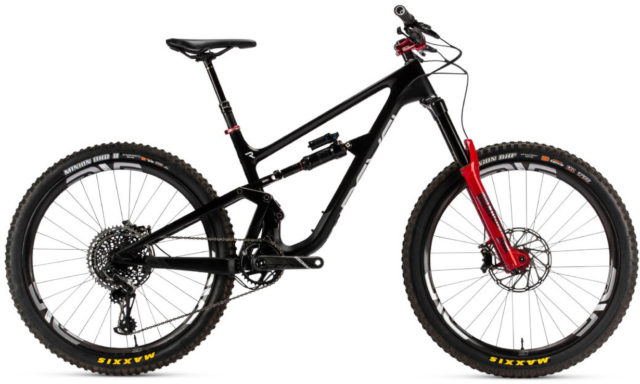
Intro
Way back when they launched the brand (which was actually just last year…), Revel introduced their 130mm-travel 29er, the Rascal, and the bike we’re reviewing here, the 165mm-travel, 27.5”-wheeled Rail.
There are a ton of bikes in the longer-travel, can-still-pedal-uphill category, so any new brand pushing a new bike into this crowded class had better find a way to make it stand out.
There are a lot of reasons why Revel is different than most brands, and you can listen to our two conversations with one of Revel’s founders, Adam Miller, for the whole backstory.
But one of the main, uncommon characteristics of all their bikes is the “Canfield Balance Formula” suspension platform around which all Revel bikes are designed. Like basically every company out there, Revel says that CBF makes their bikes efficient on the up while offering lots of traction and support on the descent, but there’s more to it than just that.
While their claims may be similar, we think their result is very impressive. Luke Koppa and I have both been riding the Rail here in the Gunnison-Crested Butte Valley, so we’ll both be offering our take on it, and we’re planning on having some additional reviewers add their thoughts down the line.
First, let’s go over the details and options of the Rail.
The Frame
Like all of Revel’s current bikes, the Rail frame is only available in carbon, with carbon used for both the front and rear triangles. It’s worth highlighting that Jason Schiers is part of the Revel team, and he’s had a long history of working with carbon during his time at Reynolds, ENVE, and now Revel. Revel claims that, due to the more complex nature of the carbon-laminate layup in their bike frames, they’re able to achieve a very high strength-to-weight ratio. The Rail isn’t a super light bike compared to other carbon options in its class, but if what Revel says is true, that should mean it’s a strong one.
The Rail has many of the features you’d expect of a modern, long-travel bike: included chain guide, chainstay and downtube protection, a threaded bottom bracket, and cable routing that’s guided and internal. (Both the rear brake and derailleur cables briefly pop out of the frame below the bottom bracket and then go back into the chainstays.)
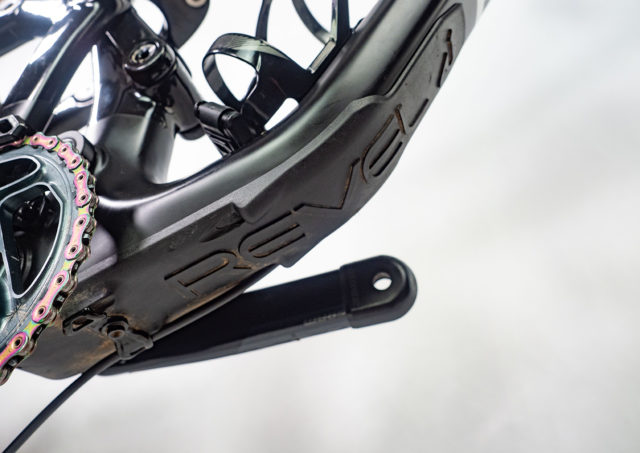
The Rail also has room for a 20-oz water bottle, though it’s a slightly tight fit, and reportedly offers clearance for up to 27.5” x 2.5” tires.
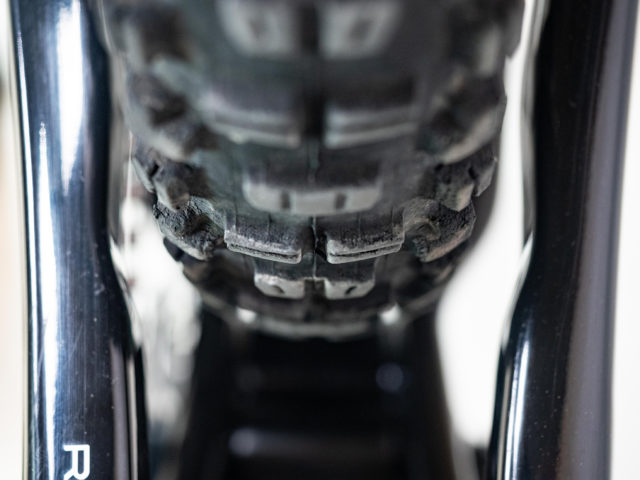
As with the Revel Rascal and Ranger, the Rail comes with a lifetime warranty against manufacturing defects for the original owner. They also have a Crash Replacement Policy for original owners, where they’ll sell a replacement part or full replacement frame at a “significantly reduced” price in the event of damage that wasn’t the result of a manufacturing defect.
The defining feature of the Rail and other Revel bikes is its Canfield Balance Formula, or CBF, suspension design. This was originally developed by Canfield Brothers and is now licensed to Revel for their bikes. You should listen to episode 28 of our Bikes & Big Ideas podcast for the whole story, but here’s what Revel says about CBF:
“CBF™ focuses on designing around the Center of Curvature (CC) and balancing that with the Instant Center (IC). Until now, most suspension systems have focused solely on the IC. CBF points the chainline and drive forces directly into the IC throughout 100-percent of the travel by balancing the CC over the chainring, resulting in maximum pedaling efficiency, regardless of where you are in the travel, what terrain you are on or what kind of power you’re putting down. All the power you put into the pedals propels you one direction–forward—allowing the suspension to do its job completely independent of drivetrain and braking forces, and making the sag setting much less important. When we first rode the largely-unknown CBF system, we knew it was something special, and we knew we could make the best riding carbon mountain bikes using this magical formula.”
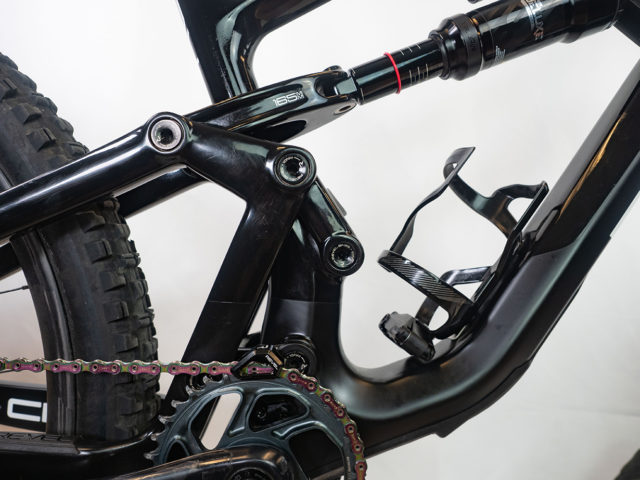
That’s a lot of words, but in the simplest terms, CBF is supposed to keep the bike efficient when you’re on the pedals, while also letting the suspension remain active and useful whether you’re pedaling hard, slamming on the brakes, or at the top or bottom of the bike’s travel. That’s a lot to ask of a suspension design but, spoiler alert, we think it’s pretty impressive once you get on the trail.
The Builds
The Rail is currently offered in three full builds, as a frame only with a shock, and a frame only with a shock and fork. For reference, here’s how the pricing of those options pans out:
- Frame Only w/ Shock: $2,799
- Frame Only w/ Shock + Fork: $3,499
- GX Eagle Build: $4,999
- X01 Eagle Build: $7,199
- XX1 AXS Build: $9,999
As you can see, the Rail is pretty short on budget options, though Revel’s pricing isn’t really out of the ordinary for a small, boutique brand these days. But those who are on a tight budget aren’t going to find a super affordable (new) option from Revel.
For the price though, the Rail builds are pretty solid. All come with Maxxis Minion DHF / DHRII tires in the EXO+ casing, and the main components are all sensible, given this bike’s intended use. Plus, you can choose to upgrade a few of the key components, including the suspension and wheelset, if you want to go with a less expensive drivetrain, cockpit, etc. but want to spend more on the more important components.
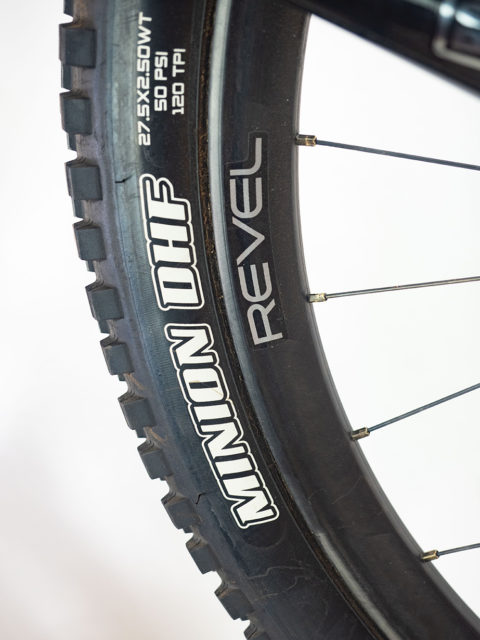
We’ve been testing a demo bike from Revel, which happened to be the top-of-the-line and very expensive XX1 AXS build.
For the hefty price of $9,999, here are some of the highlights you get with the Rail’s AXS build:
- Drivetrain: SRAM XX1 AXS
- Fork: RockShox Lyrik Ultimate RC2
- Shock: RockShox Super Deluxe Ultimate air
- Brakes: SRAM Code RSC
- Rims: Revel RW30 carbon rims
- Hubs: Industry Nine Hydra
- Front Tire: 2.5” Maxxis Minion DHF, EXO+ casing
- Rear Tire: 2.4” Maxxis Minion DHRII, EXO+ casing
- Dropper Post: RockShox Reverb AXS
- Bar: ENVE M7 carbon 35 mm x 800 mm
- Stem: ENVE M7 35 mm x 45 mm
That’s a lot of bells and whistles. If you want, you can also get a Fox Factory 38 fork and Factory X2 shock for an extra $450, swap the Super Deluxe for a MRP Hazzard Coil for $350, or go with the Factory 38 fork and Hazzard Coil shock for $500. These suspension upgrades are available on all of the other Rail builds, too.
Thoughts on the AXS Build
Eric Freson: With a build in this price range, there shouldn’t be anything to point out as holding back the bike. And, true to form, there isn’t much I can complain about with the Rail AXS build. If you have a problem with the spec on this bike, I’d say it’s going to come down to personal preference, rather than a need for greater performance from any individual component.
An integral and interesting part of the AXS build is Revel’s own RW30 carbon rims. Similar to what reviewer Ben Sims said in his review of the RW30 wheelset, these carbon rims didn’t feel as much like “traditional” carbon rims to me as I expected. What I mean is that I found them to skew heavily to the “compliant” side of the spectrum in terms of on-trail ride feel for a carbon rim — damped and not chattery.
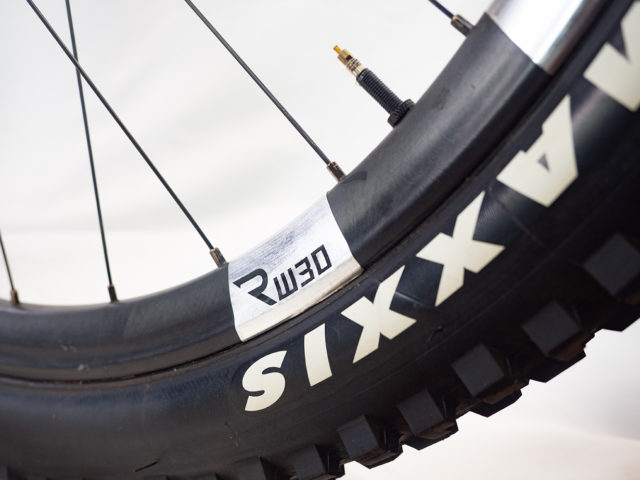
To me, this is a double-edged sword; the RW30’s traction under load was excellent for a carbon rim, and I never felt them flexing out under any hard cornering loads or large g-outs. But the trade-off is that, if you enjoy the precision or super quick feel that stiffer, traditional carbon hoops often afford you, I didn’t find those sensations as noticeable with the RW30 vs. other carbon options out there. In my mind, this is by no means a knock against the RW30’s — they just felt very “normal,” particularly coming from aluminum rims.
Suspension is hugely important to me, and I have really enjoyed my time with the RockShox Lyrik Ultimate and RockShox Super Deluxe Ultimate that are spec’d on the Rail AXS. Having compression adjustments on the Lyrik Ultimate made it easier to dial in than the Lyrik Select + I was also recently riding on the Santa Cruz Hightower, and I was impressed by the very supple feel off the top of both the fork and shock’s initial stroke / travel. Overall, I’m a big fan, and I was able to quickly dial in both the fork and shock.
This was my first time riding ENVE’s M7 carbon bars and I found them to be damp without feeling overly stiff or harsh — just what you want (at least at my weight) in a carbon bar. This isn’t always the case with carbon bars in my experience, so it’s worth noting.
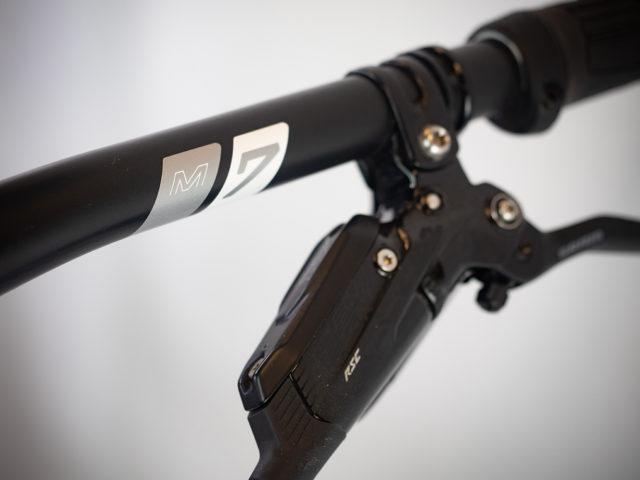
While reviewers David Golay and Ben Sims noted that they’re not as loud as i9’s previous hubs, the Hydra hubs are still loud. You’ll know if you like this or not without needing to hear one. But man, they are fast to engage!
Finally, I’m not totally in love with the AXS derailleur. The shifting was spot on. The ability to change shift pattern direction is rad. Dropping jokes about Bluetooth is fun. Effortless and single-push indexing through all the gears is addicting. But … I ran out of juice on a ride. Which wasn’t cool (but also kinda on me).
My real / honest gripe with the AXS derailleur is that, for those like me who move your hands around on the bars a fair bit or frequently find yourself picking up your bike over logs or other obstacles, there were multiple occasions where one of my fingers would hit the AXS shifter paddle and I wouldn’t realize it was happening, only to have the bike be super unhappy and trying to move through a bunch of gears unexpectedly as soon as I began to pedal again. No deal-breaker, but an example of how an improvement in technology meant I needed to re-learn how I approached something I know well.
Luke Koppa: I’m still relatively new to biking and therefore don’t often notice every single component on a given bike. That said, a few of the high-end parts on this high-end build were definitely noticeable to me.
First off, while I don’t think I’d buy it for a personal bike, the reliable, quick, consistent shifting of the AXS system was awesome. It also impressed me in terms of how well it shifted under load, though I’m not sure if it’s quite as good as Shimano’s 12-speed XT drivetrain, which I only got to spend a bit of time on but that was impressive in that regard. Compared to my personal SRAM GX drivetrain, which has required very frequent service to keep it shifting smoothly and is even then a bit finicky, the AXS system’s ease of use and consistency was amazing.
I didn’t have any issues with accidentally pressing down the shifter and consequently sending it shifting through the whole range of gears. That said, if I had AXS on a personal bike, I’d probably change the settings via the app and remove the option to shift a bunch of gears by holding down the paddle. Quickly tapping the pedal multiple times works just fine for me.
One of the most surprising things I found myself loving was the Revel RW30 / i9 Hydra wheelset. I never figured I’d notice the lower weight of a carbon rim, nor the extra points of engagement of a high-end hub, but I was wrong. I definitely noticed the lack of weight of the rims more than the ridiculously fast engagement of the Hydra hubs, but I appreciated both.
The instant-feeling engagement was nice on techy climbs, but mostly I liked how light the front end of the Rail felt, given its 170mm-travel, not-super-light Lyrik Ultimate up front. Despite not objectively being super light at a little over 32 lbs for a size Large, the Rail AXS felt much more nimble than I expected, which seemed in large part due to the lighter wheelset.
On Eric’s note about the RW30’s ride feel, I’ve spent the vast majority of my time on aluminum rims, and the RW30 felt familiar to me, apart from feeling lighter. I think I’ll need to ride a lot harder and for a lot longer before I begin complaining about any wheel’s lack of stiffness, but you can read Ben Sims’s full review of the RW30 wheelset for his more detailed take on the RW30 rims.
Overall, I have nothing to complain about with this build, as I would hope, given its price. Personally, if I were to own a Rail, I think I’d just go with the GX build and maybe add the RW30 wheelset or just build it up from the frame-only option. Riding a bike that costs more than my car scares me and my wallet, but yeah, the performance is pretty awesome.
Fit & Geometry
Like Revel’s other bikes, the Rail isn’t pushing the boundaries of geometry, but it’s also not conservative or dated.
For the size Large we’ve been riding, here are some key numbers:
- Reach: 470 mm
- Head Tube Angle: 65°
- Seat Tube Angle (effective): 75°
- Chainstay Length: 430 mm
- Wheelbase: 1230 mm
There are lots of bikes with similarly large amounts of travel that are notably longer, lower, have slacker head angles, and / or steeper seat tube angles. E.g., the recently revised, 2020 Specialized Enduro, the new Commencal Meta AM and Clash, and even shorter-travel bikes like the Transition Scout and Norco Sight.
So, while the Rail’s geometry isn’t at the forefront of current trends, its numbers still seem (and feel — see below) pretty sensible for a longer-travel bike. FWIW, it’s not far off in terms of geometry compared to the Santa Cruz Megatower, and while the two bike’s numbers aren’t crazy, the Megatower is a very capable bike at high speeds.
Interestingly, the Rail’s geometry numbers look very similar to the previous, 2019 version of the Specialized Enduro 27.5, with the Enduro 27.5 having a 466 mm reach, 433 mm chainstays, and a 1225 mm wheelbase (size Large). The Enduro 27.5’s head angle is identical in its low setting and its effective seat tube angle is a bit steeper at 76.6°.
For reference, here’s the whole geo chart for the Rail:
Thoughts on Fit & Geometry
Eric (5’10”, 165 lbs): As a 27.5”-wheeled bike in 2020, the Rail does feel a bit like an idea that was put on paper a few years ago as something pretty progressive and then made it to production last year as something more “average” compared to the other options out there. But once I got on the Rail, I didn’t see that as an issue.
I dig the geometry and at this point, it just feels “familiar.” It’s very easy to adjust to and quickly begin riding quite fast. E.g., with the Rail, I don’t think you’re going to need to re-learn how to attack a low-speed corner or re-position your body in the saddle to get to grips with it. It quickly feels like an old friend.
And with the “Enduro” segment of bikes being dominated by 29ers these days, it was interesting and fun to hop back on a longer-travel, 27.5”-wheeled bike for a bit. I adjusted to the difference in wheel size within a few corners on the first descent. Wheel size didn’t impact the fit for me in any other perceptible way, just ride characteristics, which I’ll touch on later.
With a reach of 470 mm and an effective top tube of 642 mm, I wasn’t expecting to ever feel cramped on the Rail. And for the most part, I didn’t. However, one aspect of the fit of the Rail with which I struggled a bit was the cockpit length when climbing out of the saddle. I’d find myself feeling like I was too far over the front end, and up over the bars more than I wanted to be when attacking out of the saddle. Consequently, I had to make a point to not let myself get too far over the front wheel when I was tired, in order to avoid taking too much weight off the back of the bike and spinning out the rear tire.
I haven’t felt this sensation as intensely on other similarly sized bikes I have tested recently, so I don’t have a good explanation as to why I was feeling it. I set my bar height where I normally like it, the handlebars don’t have a crazy sweep to them, and I wasn’t running my fork any softer than normal. But if I owned a Rail, I’d be experimenting with a slightly longer stem length, which just sounds odd to say these days.
Luke (5’8”, 155 lbs): At 5’8”, I’m outside of the recommended height range for a size Large Rail, and I’m usually quite comfortable on most bikes in a size Medium. But I wanted to give this bike a try, and overall, I still got along pretty well with the size Large Rail.
Converse to Eric, I felt a bit stretched out while climbing — I found myself moving forward on the saddle during steep climbs and would sometimes end up with a sore back after long climbs (which could be partially due to poor form on my part). The flip side was that I very rarely had issues while pedaling out of the saddle. On the up and the down, my weight felt pretty centered in the bike, which meant I didn’t have to concentrate very hard to keep the rear wheel from spinning out while climbing nor be super active in terms of moving my weight around on descents.
In the end, I got along better with the size Large Rail than I expected, given that it’s arguably too big for me. I would’ve appreciated a slightly steeper seat tube angle for steep climbs, but I had few complaints. That said, I think I’d personally be happiest on a size Medium, particularly since I have a relatively short torso compared to my overall height, and so I doubt I’d run into the cramped feeling that Eric noted.
Ride Impressions
Climbing
Eric: There’s no way around it — the Rail climbs really well. Especially for what it is as a larger, heavier, longer-travel bike. That said and in my opinion, it doesn’t feel drastically different to me than some other dual-short-link-style suspension designs currently on the market, such as Santa Cruz’s VPP or the DW Link design used on Pivot’s current bikes. The Rail feels efficient, I feel my input translate to forward motion, and I don’t think many people will find themselves reaching for the shock’s climb switch, like, almost ever. The Rail is really good on the up, I just wouldn’t say it’s some revolutionary bike in terms of climbing prowess.
The biggest aspect of climbing on the Rail that stood out to me was that I really didn’t feel the bike’s climbing performance change based on where the shock was in its stroke. E.g., if you compress the shock heavily while seated and immediately start pedaling, you really don’t feel the wallow impact climbing performance. This is right in line with what CBF claims to do, and I would say it’s no exaggeration here. The Rail’s anti-squat is spot on, everywhere.
The Rail is efficient enough to be at home most anywhere. Rolling terrain didn’t immediately feel tedious, and pushing hard and keeping my heart rate elevated aboard the Rail didn’t feel like wasted effort. Yes, this is a big bike for big descents, but when I’d ride the Rail in mellower terrain, I never caught myself wishing for something different. It’s a big bike, and I’m not trying to say it’s going to replace something with shorter travel as your go-to for rides with big climbs or spirited sprints, but it’s enjoyable everywhere, and not a bike I feel like I simply “deal with” on the ups, to enjoy the downs.
As I noted in the fit section, my only gripe when climbing on the Rail was that I had to focus on my weight distribution when I was out of the saddle and attacking the trail, in order to avoid spinning out the rear wheel. This was a bit of a surprise for a somewhat long and roomy bike, but this isn’t a bike that’s suited to out-of-the-saddle attacks everywhere anyway, so it was not something I noticed a ton, either.
Luke: For reference, I’ve been spending the past year on a size Medium 2019 Specialized Enduro 27.5”. That bike is excellent in terms of traction, but pretty bad in terms of pedal bob / efficiency.
So, with that point of reference, I was pretty blown away by the Rail’s climbing characteristics. It felt like just about every bit of power I put into the pedals translated to forward motion, and I could barely notice a difference whether the shock was locked out or not. And I agree that it felt great no matter where I was in the travel, which I very scientifically tested by frequently forgetting to change the shock’s pressure / sag after some much heavier and much lighter people had been riding it…
To me, the most surprising and impressive aspect of the Rail’s suspension on the up was how well it seemed to balance both minimizing pedal bob with traction. The Enduro 27.5 feels like a bike that is very much a compromise — great traction, but at the cost of efficiency. The Rail, on the other hand, basically never had me feeling like I was struggling for grip on climbs, while also not feeling like it was absorbing and dissipating a significant amount of the power I was putting down on the pedals.
Overall, I loved pedaling this bike, for what it is. I found myself staying in harder gears and going faster, cleaning techy climbs that I hadn’t in the past, and overall feeling more fresh at the top, compared to my time on the wallow-y Enduro 27.5.
Descending
Eric: When it comes to getting the rear suspension to quickly feel dialed, CBF is no joke. The Rail is very forgiving to setup changes and operates well within a huge margin. I ran anything between 25% and 35% sag while riding, and the Rail never felt like it was becoming compromised due to too much, or too little sag. CBF’s Instant Centering does in fact work really well throughout the bike’s sag range, as claimed.
While a 27.5” wheel may not roll over and through trail chatter as well as a 29” wheel does, the Rail carries speed extremely well. The back end of the bike got up and out of its own way and kept me moving forward and down the trail with little intentional effort on my part as the rider. I’d say the Rail falls into the “supportive” side of the rear-suspension continuum of squishiness, rather than “ultra plush.”
There are more supple-feeling bikes out there, but the Rail counters that by really giving me the confidence to attack trails with little regard to what I might find in the middle of a chunky section, thanks to its strong mid-stroke support and invisible ramp-up near the end of the bike’s travel. I really enjoyed that the Rail could be at home during both mellow group rides and race laps alike, and didn’t ask to be ridden in only one way to feel comfortable.
Overall, the Rail is a fast bike, and the smaller wheels make it fun to pick it up and place it deliberately throughout the trail. It inspired confidence, and I didn’t have more or less fun on the bike based on the type of the trail I was riding, which can’t be said for all long-travel, Enduro-ish bikes on the market today. The steeper, rougher, and the looser the terrain, the more I appreciated the Rail, since that sort of terrain more noticeably showcases the bike’s strengths. But the Rail isn’t a bike that needs to be pigeonholed into a particular type of terrain to be enjoyed to its fullest.
What stood out to me most when piloting the Rail downhill was just how phenomenal its braking traction was. On most bikes, you can pretty easily skid and lose the rear tire under heavy braking when you dive late into a corner and pull hard on the brakes. But on the Rail, I almost never lost grip, and it got to the point where I was pushing the limits of just how late I could brake before a high-speed corner in an effort to find the point where the Rail would finally give up rear-wheel traction. It was hard to find. Because of this, I think the Rail would be a lot of fun in bike parks, loose trails, rough trails, and other places where braking traction plays a huge role in cornering speed.
Overall, the Rail descends like you would expect a 165mm-travel bike to when pointed downhill. The geo numbers are long and slack enough that I felt like I was hitting the brakes before the bike needed me to, and its carbon wheels stay strong in a berm longer than my arms would. I think the fact that I experienced no negative surprises, only positive ones, in the Rail’s behavior when pointed downhill is a testament to just how refined and polished the Rail is on its first iteration, and just how well the CBF suspension platform performs. I’d consider that pretty high praise, even if it’s not particularly sexy or grandiose.
Luke: Yep, Eric summed it up very well. The Rail didn’t make me quite as confident on super steep terrain as some of the slacker 29ers I’ve ridden, and it’s still a fairly heavy, long-travel bike and therefore doesn’t feel super sensible on very flat, smooth terrain. But for everything in between, it felt surprisingly comfortable, particularly given how much travel it offers.
The main thing I’d like to re-emphasize from Eric’s thoughts is that you do not need to be riding this bike super hard to enjoy it. As a far less aggressive rider than Eric, I (unsurprisingly) never felt like I was coming close to this bike’s speed limit, but it also felt very manageable at slower speeds.
I agree that it’s not the most plush, squishy bike out there, but it also carried speed through chunk much better than the more plush, squishy Enduro 27.5. Because of this, its excellent braking traction, and its generally very predictable nature, I found myself riding faster on the Rail than I have on most bikes.
I also liked that, while it’s not very light and the size Large is bigger than most bikes I’ve ridden, the Rail was still pretty easy to get in the air and flick around. Maybe part of this was due to the fairly light RW30 rims, but as someone who tries to find as many little side hits as possible to make up for my lack of speed, I didn’t feel like the Rail was holding me back in terms of playfulness.
In the end, the fact that both Eric and I got along very well with the Rail on the descent with very few complaints says a lot about this bike’s versatility.
Comparison: Revel Rail vs. 2019 Specialized Enduro 27.5
Luke: While this version of the Specialized Enduro is now discontinued, it is a pretty good comparison since the bikes are extremely similar in terms of travel and geometry. And the current, 2020 Enduro is only available with 29” wheels and has very different geometry vs. the Rail, so that feels like much less of an apples-to-apples comparison.
Overall, the Enduro 27.5 and Rail feel similar. Neither feels specifically inclined to find the absolute fastest line down the mountain, particularly compared to their longer / lower / slacker, 29er competition. But both are very easy to get along with and can work for a lot of people who don’t have maximum high-speed stability as their only priority.
The biggest difference comes down to their suspension designs. While both offer excellent traction on climbs, the Rail manages to do that while also being significantly more efficient in terms of not feeling like every pedal stroke sinks it down into its travel. The Rail offers a really appealing combination of great traction and minimal pedal bob, while the Enduro feels like it offers the more traditional compromise of excellent grip but with significant pedal bob.
What this translated to for me was cleaning climbs on the Rail that I’d usually have to walk with the Enduro since I couldn’t keep enough momentum going forward. It also meant I basically never felt the need to flick the Super Deluxe’s climb switch on the Rail, whereas I do that on any sort of smooth trails on the Enduro 27.5. That made the Rail not only nice for techy, steep climbs, but also for the mellow fire roads around Crested Butte, which often have a layer of dust and / or kitty-litter gravel over them.
On the descent, the Enduro 27.5 wins in terms of overall “plushness” — its suspension feels more active and like it does a slightly better job of making small- and medium-sized hits less noticeable. With that said, I also felt (and was) a lot faster on the Rail since its rear suspension was noticeably less prone to getting hung up / slowed down on square-edge hits. While the Enduro 27.5 does a great job of absorbing impacts, that seems to come at the cost of maintaining speed through chunk. The Rail might not quite match its ultra-plush feel, but the Rail was better at carrying speed and it still offers much of the smooth feel you’d expect from a 165mm-travel bike.
In my experience, the Rail offers nearly all of the upsides of the Enduro 27.5, but without its downsides. If you liked the fit and geo of the Enduro 27.5 but found it too wallow-y on climbs or too “catchy” and slow in rough terrain, the Rail should be on your list.
Bottom Line
Eric: The Revel Rail is an impressive bike. The attention to detail in every aspect of the Rail’s design is obvious. The AXS build spec is top shelf and won’t leave you wanting (and it’s super cool they give you so many options with your own build).
This bike is incredibly easy to set up and very forgiving of a rider’s setup preferences, rather than needing to operate within a small range of settings to perform at its best. The speed it will carry — and most impressively to me — its traction under braking is exceptional. CBF has moved to the top of my list of favorite suspension platforms after my time with Rail.
With how much attention that long-travel 29ers get these days, many will likely overlook the Rail, and this is their loss. While I’m a bit of a 29er fanboy myself, if I needed to find a bike that was going to spend ~50% of its time in a bike park, shuttling, or other places where brake bumps tend to eat you alive, the Rail would be high on my list. If your riding doesn’t incorporate as much machine-built terrain and instead lots of rocks / chunk, then the wheel size of the Rail will likely become more important in your decision, but this is due to personal preference on wheel size, rather than anything the Rail in particular doesn’t do well.
It is interesting to see a new, boutique, carbon bike in this space with 27.5” wheels, but who’s complaining about that?! I found the Rail to be incredibly well rounded, easy to live with day in and day out, and just generally a bike happy to meet me wherever I was at for the day, which is not something all bikes are willing / able to do.
Riding the Rail has made me really, really want to spend some time on the 130mm-travel, 29”-wheeled Rascal, because I like everything that Revel has going on right now and am excited to ride more of their bikes in the future.
Luke: Agreed — the Rail is impressive. I loved the CBF platform’s ability to balance climbing efficiency with great traction on the up and down, and the bike’s overall design made it feel comfortable in a wide variety of terrain and speeds, particularly given its longer-travel design.
Some may want more “modern,” aggressive geometry, and others simply won’t want 27.5” wheels. But if given the chance, I’d encourage just about everyone to try the Rail. It’s a bike that is surprisingly versatile, both in terms of terrain and the variety of riders that will appreciate it.

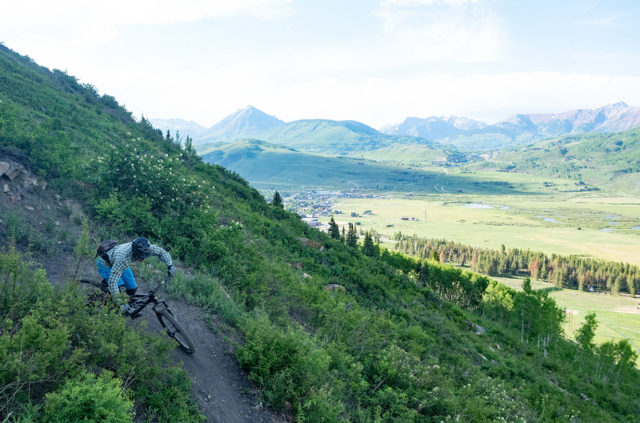
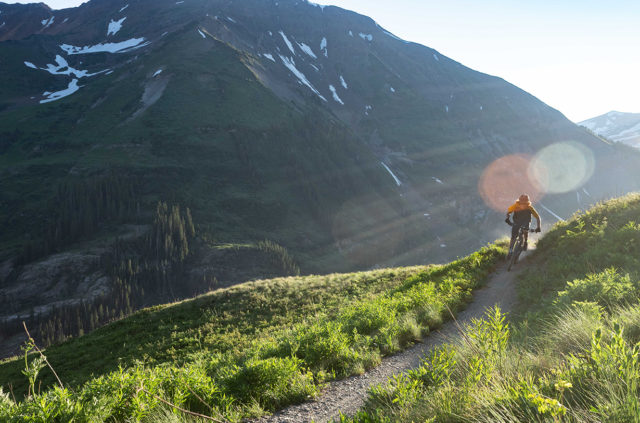
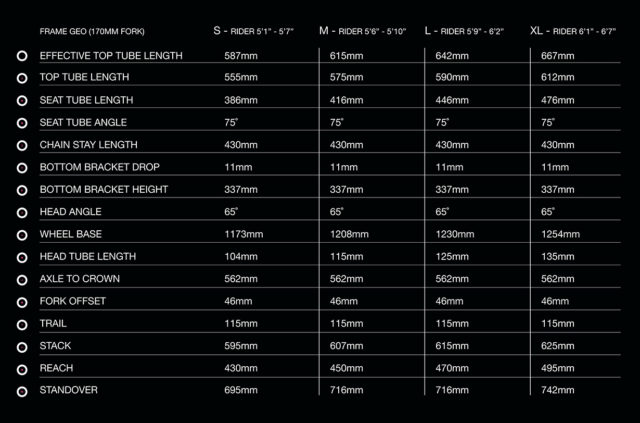
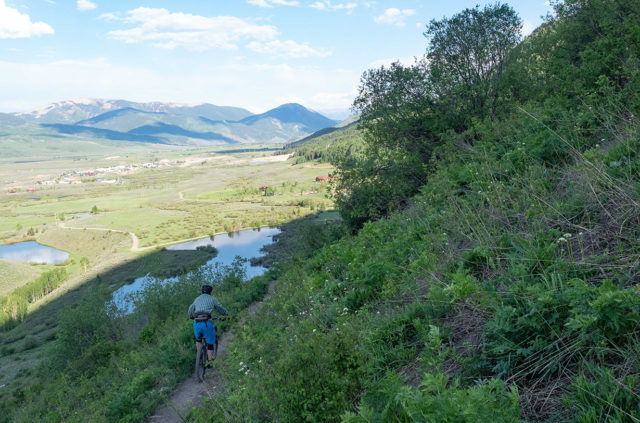
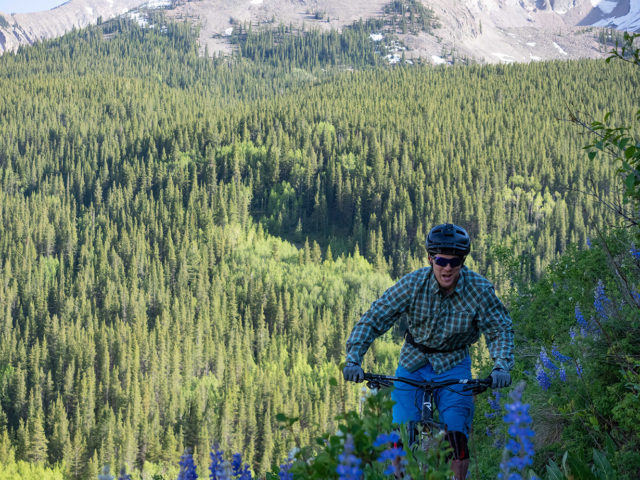
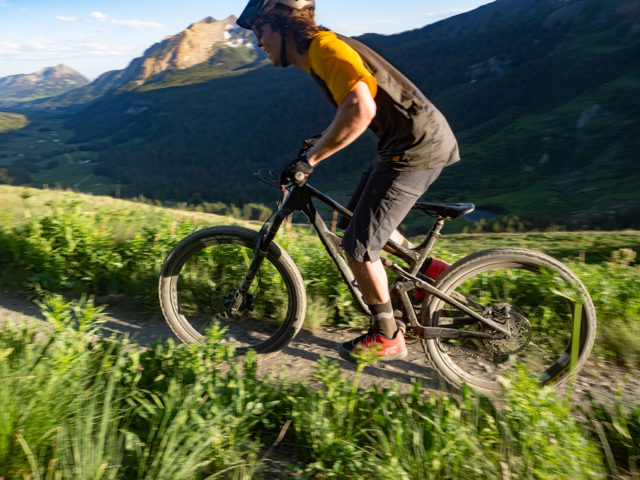
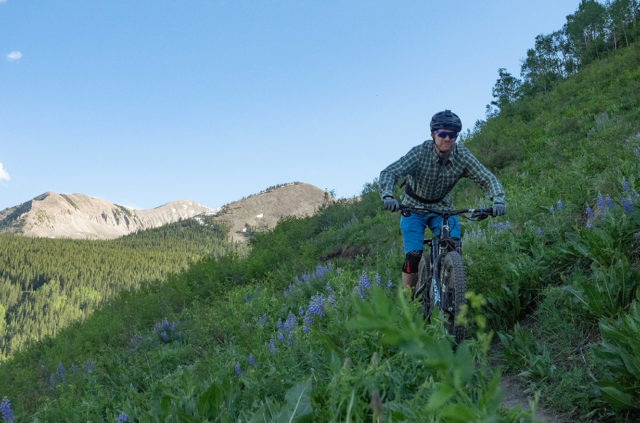
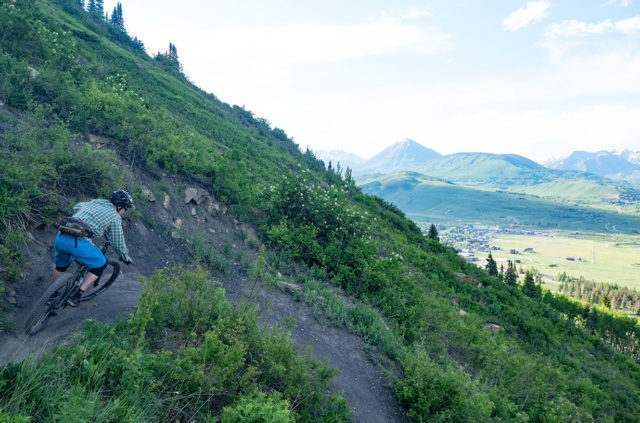
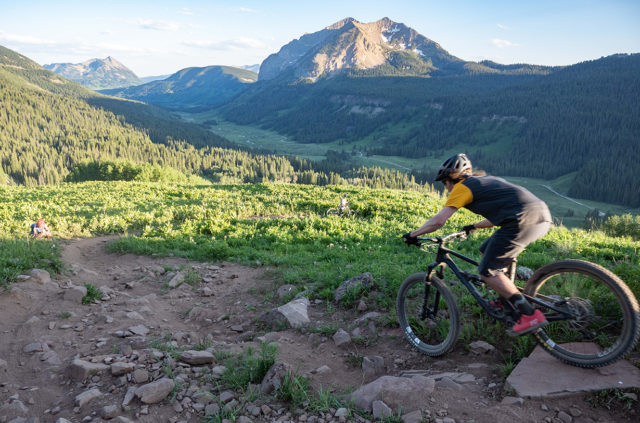
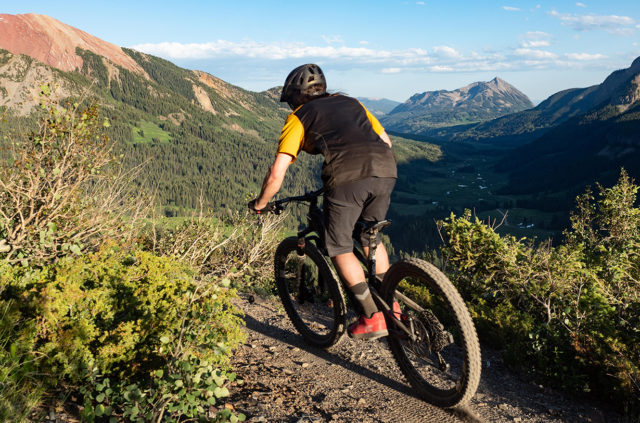
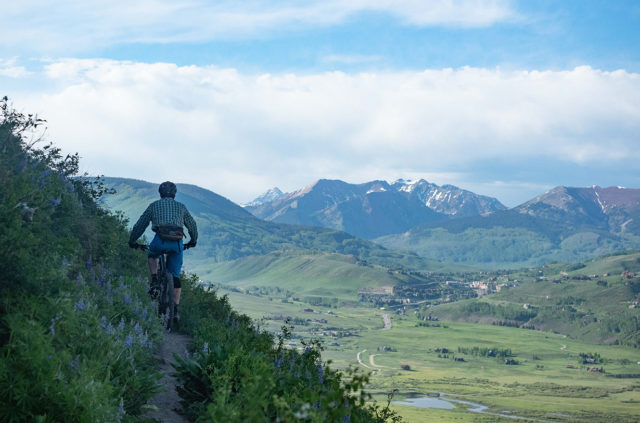
How would you compare the Rail to the Yeti SB165?
Hey Ryan, haven’t had a chance to get on a SB165, so I can’t make that comparison.
The Rail is in my top 3 contenders for next bike. At 5’9.5″ I’m totally on the fence on Med/Lg. Probably keep it medium for fun factor over warp speed stability. Wheelbases in the 1230 range seem too long, but my experience with those long WBs has been on 29ers which may amplify the negative impacts. Dunno. Any comparison to the Transition Patrol or new Knolly Warden? Those are also on my list.
Im a proud an very happy, satisfied….so on owner of a Revel Rail.
Using it in bikeparks, on trails and everything in between.
Would say its a perfect allround bike that always put a smile in your face.
Riding a size M and im 5,51ft and it fits me perfect.
Til next season im planning to run it as a mullet with a dual crown MRP Bartlett fork and coil shock.
I am demoing a small Rail. I am 5’5.5″. The numbers say it should be longer than m 2019 Bronson V3 small. It feels shorter than the Bronson though the numbers say different, in fact, the same sensation as the tester not being able to explain feeling a little cramped. How long of a stem would you suggest before you went up a size? A 50mm stem feels just about right but I am trying to figure out if I want my weight that far forward all the time. Thanks